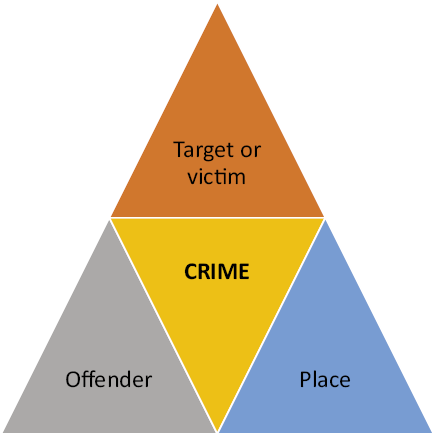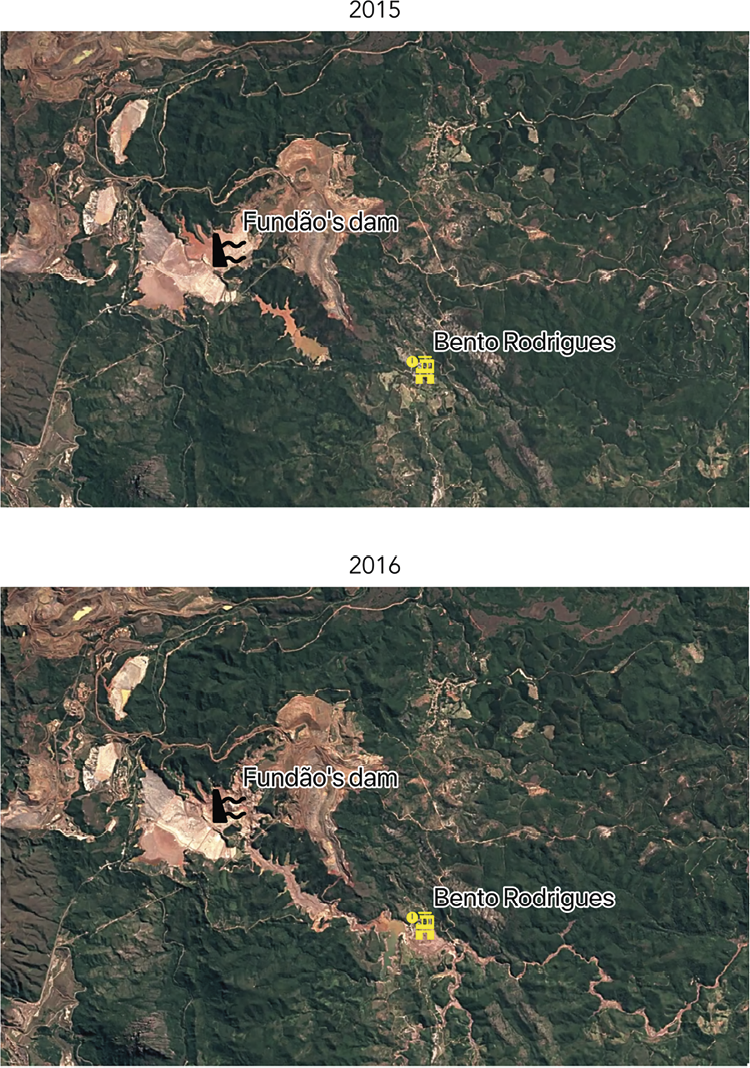Cosmopolitan Civil Societies: An Interdisciplinary Journal
Vol. 15, No. 1
2023
ARTICLE (REFEREED)
Impact of Dam Collapses on Violence in Minas Gerais, Brazil
Rafael Lara Mazoni Andrade
Minas Gerais Public Safety Observatory
Corresponding author: Minas Gerais Public Safety Observatory, 4143 MG-010 Road, Belo Horizonte, Brazil – ZIP 31630900, rafaelmazoni13@gmail.com
DOI: https://doi.org/10.5130/ccs.v15.i1.8297
Article History: Received 23/07/2022; Revised 25/02/2023; Accepted 06/03/2023; Published 26/03/2023
Abstract
The mining sector, over a number of centuries, has become a strong cultural attribute of Minas Gerais. Due to its mining reserves, the state has the biggest concentration of tailings dams built to retain mining waste. This led to large-scale accidents in the last decade – in Mariana (in October 2015) and in Brumadinho (in January 2019). These accidents have shifted the debate about mining in the region, and more widely changed the leading forces among society, bringing a new equilibrium to social relationships. The objective of this paper, as part of a monitoring effort, is to assess the impacts of these accidents on crime and violence as a new face of extractivism. The results can be used to design better responses in terms of welfare programs or compensation efforts, leading to a better and more responsible extractivism.
Keywords
Tailings Dam Disaster; Extractivism; Violence; Impact Assessment; Brazil
Introduction
Minas Gerais state, in Southern Brazil, is known because of the biggest concentration of tailings dams built to retain mining waste, according to data from Brazilian National Agency on Water. This concentration has led to large-scale accidents in the last decade. On November 5th, 2015, Fundão’s mining dam, managed by Samarco, collapsed in Mariana, 150 kilometres from Belo Horizonte, killing nineteen inhabitants of Bento Rodrigues, and destroying up to three hundred houses. The accident had impacts through the Rio Doce water basin, affecting thousands of people from Minas Gerais to Espírito Santo, at the Atlantic Ocean. On January 25th of 2019, Mina do Feijão’s mining dam, managed by Vale, collapsed in Brumadinho, 50 kilometres from Belo Horizonte. This massive accident killed almost three hundred people, representing not only a humanitarian disaster, but also one of Brazil’s worst environmental disasters. The collapse destroyed forests and polluted rivers across the region.
These accidents have changed the way in which civil society sees the mining sector both in the Minas Gerais region and in the wider country, breaking the usual royalty-based partnership with the big players in the mining sector. Further, these accidents have changed the leading forces among society, bringing a new equilibrium to social relationships. Due to the changed social relationships, these accidents have also had an impact on crime and violence in these regions.
The objective of this paper, as part of a monitoring effort, is to assess the relationship between the accidents and the incidence of crime and violence in the local towns of Mariana and Brumadinho, as reflecting the new face of extractivism in the region.
The Context of Minas Gerais
As its name denotes, the state of Minas Gerais (‘General mines’) has relevance because its territory is rich in minerals. Throughout the 17th century, the Portuguese Crown sought new sources of income in its colony, which led to the discovery of minerals in its interior regions. In turn, there was an influx of miners in the valleys and mountains of Minas Gerais, in search of wealth and motivated by the Roman principle of uti possidetis, which advocated territorial occupation (Del Priore & Venancio 2010). Together with its geology, this ideology was a fundamental factor in the attraction of immigrants to Minas Gerais, creating a marked predisposition to mineral extractivism in the locality (Carvalho Filho 2008). The mining sector, through all these centuries, has become a strong cultural attribute of Minas Gerais. The state has attracted many entrepreneurs since then, such as Vale, Samarco, Anglo Gold, Usiminas and many others. In 2017, the industry and mining sector represented 22.28% of Minas Gerais’ Gross Domestic Product, up to four times bigger than agriculture, forestry, and livestock altogether, as shown in Table 1.
Source: João Pinheiro Foundation (FJP), Board of Statistics and Information (Direi). Brazilian Institute of Geography and Statistics (IBGE), Brazilian National Account Coordenation (Conac).
Due to its mining reserves, the state also has the biggest concentration of tailings dams built to retain mining waste, according to data from Brazilian National Agency on Water. The map below (Figure 1) presents the dam density in Brazil, highlighting the centrality of this region.
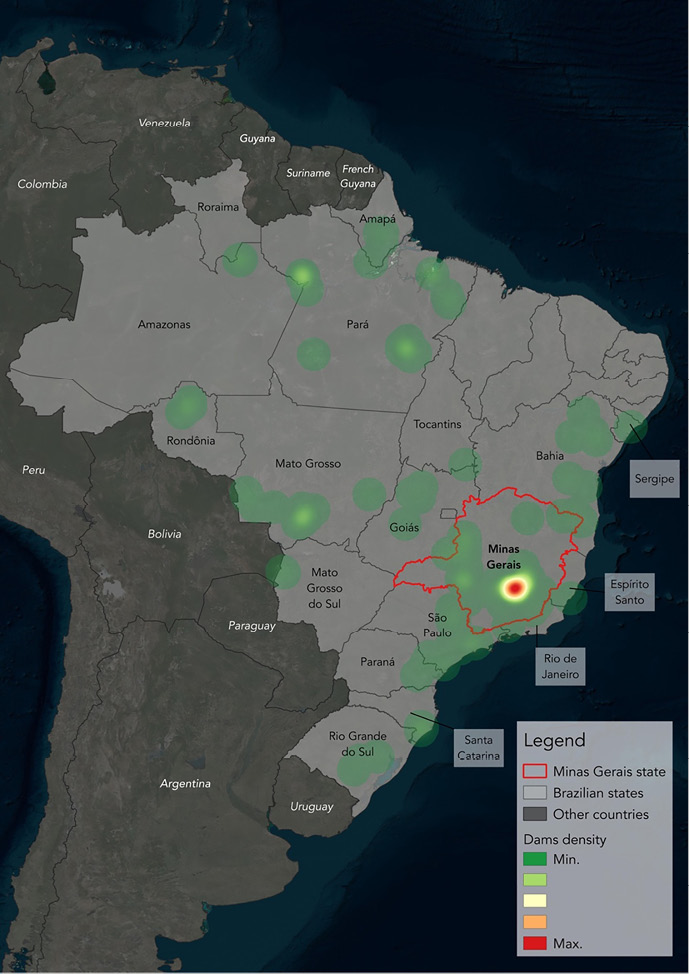
Figure 1. Density of dams in Brazil, highlighting the state of Minas Gerais
Source: the author, with data from National Mining Agency (2019)
This concentration has led to major accidents in the last decade, as in Mariana in 2015 and in Brumadinho in 2019. Exploring data from Mariana and Brumadinho more than one year before the second big accident, Coelho (2018) points to what he calls ‘mineral-dependence’. In these cities, the development of mining activities comes at the cost of other activities that could be explored in the local economy.
According to Coelho, the fiscal needs of both the state and the mining cities shortened time horizons. Economic activity centered on mining has been reproduced for decades, sometimes centuries, following the same trend trajectory, despite the problems caused. The state of economic inertia of these economies is only changed when mineral reserves are exhausted or extraction becomes economically unfeasible, or, in more extreme cases, when major disasters occur, such as tailings dam ruptures (Coelho 2018).
Social change and violence
As noted, recent mining accidents have been associated with crime and violence in the region. Among the explanations for the occurrence of a crime, environmental criminology has emerged as a reflection of the maturation of space-social theories – whose touchstone is the statement that all criminal acts occur in some space. In part inspired by Oscar Newman’s early physical approach (Newman 1972), discussions on this issue today are characterized by a more integrated conceptualization, considering several aspects that may influence different types of crime, going beyond the approaches that concern the reasons why criminals are engendered, to think about the circumstances in which crime is carried out (Beato Filho 1998; Clarke & Eck 2003; Gartner 2008; Guillén 2013). Clarke and Eck provide a concise and useful statement:
Most criminological theories focus on what makes people criminals. They find causes in distant factors, such as child-rearing practices, genetic makeup, and psychological or social processes. These theories are very difficult to test, are of varying and unknown scientific validity, and yield ambiguous policy implications that are mostly beyond the reach of police practice. But […] the theories and concepts of environmental criminology (and of the new discipline of crime science) are very helpful in everyday police work. This is because they deal with the immediate situational causes of crime events, including temptations and opportunities and inadequate protection of targets (Clarke & Eck 2003, p. 26).
This area of study of environmental criminology developed in the late 1980s, based on studies by Paul and Patricia Brantingham, considering contextual and related factors related to the surroundings to explore how opportunities for criminal practices and antisocial behaviours are produced (Gartner 2008; Guillén 2013). The fragmentation of the territory, its privatization and the emptying of public spaces perpetrate the feeling of insecurity – which is consistent with private security solutions in the form of buildings and walls, as stated by Caldeira (2000), Siqueira (2016) and Figueira (2016). As Guillén (2013) outlines, environmental criminology is based on three premises:
(i) the environment significantly influences the deviant behaviour,
(ii) offences are not randomly distributed in space and time, focusing on some concrete places and moments, so that it is possible to establish specific areas that are more likely to occur in a crime – so-called hot spots, and
(iii) strategies based on interventions in urban space can help to respond to the problem of insecurity and violence.
At the heart of environmental criminology is the theory that the characteristics of criminals – such as their affiliation, genetics, and social and psychological processes – cannot explain criminal dynamics. Instead, it uses the analysis of routine activities of victims, temporally and spatially located, to explain these criminal dynamics (Clarke & Eck 2003; Sapori & Soares 2014). Originally formulated by Lawrence Cohen and Marcus Felson (1979), this approach suggests that crime occurs when a probable offender and an appropriate target converge at the same time and place, without the presence of a skilled guardian – be it a human actor or a security outfit (Clarke & Eck 2003; Sapori & Soares 2014).
From this, one can illustrate the theory of routine activities through a triangle that brings with it each of the factors listed above, the location, the criminal and the target, as well as its controls – respectively, the manager, who controls the behaviour of the people in that place, the supervisor, who knows the aggressor and exerts some control over their actions, and the guardian, who protects the victim (Clarke & Eck 2003):
Figure 2. The Problem Analysis Triangle
Source: The author, inspired by Clarke & Eck (2003, p. 26).
Thus, as Sapori and Soares (2014) suggest, lifestyles and habits define the time people allocate in each activity, deriving the risk of victimization from the following five factors:
• Exposure to public places, in the time allocated to contacts and social interactions,
• proximity between victim and aggressor and frequency of contacts between them, data their places of residence, characteristics of age and sex and interests,
• protection capacity, related to the lifestyle of the victims - since the lower the contact with possible aggressors, the lower the risk of being victimized,
• attractiveness of the victims, related to the impossibility of resistance or related to the expected return of the crime,
• nature of the crime, which determines the proportion of each factor to the probability of victimization.
However, given the social impacts related to dam collapses, it is necessary to broaden the view on the motivation for crimes. In a situation of limited freedom and increased social isolation, in the context of uncertainty related to the collapses and the risk of economic setbacks, individuals may be subjected to negative stimuli – such as stress – that could lead them to experience a series of negative emotions that, uncontrolled, can lead to the commission of a crime (Agnew 1992).
The Mineral Technology Centre (CETEM), cited by Fontes and Lopes (2017), listed increased violence as one of the socioeconomic impacts of mining activity, along with a range of other impacts, such as the proliferation of diseases, labor problems with mining companies, land use issues, disordered growth of the municipality and lack of infrastructure to serve the population, low economic and social growth of the municipality, increased prostitution, impoverishment of the population in general and child labor.
The tendency to increased violence in society is associated with territorial insecurity and the re-management of entire communities to carry out mining activities, often in a forced manner. Against this background, the following study investigates the extent to which mining accidents are likewise associated with an increased incidence of crime and violence, focusing on the affected towns of Mariana and Brumadinho in Minas Gerais. In this context, it would be expected to observe a rise in all the kind of crimes.
According to Agnew (1992), a situation of stress impacts on a rise of interpersonal violence, what would be represented by a rise in homicide and injury occurrences. For the crimes against someone’s property (such as theft), it is hard to assume the expected trend: it could either drop or rise, depending on its specific aspects. This kind of crime depends on a situational aspect, based on opportunities to commit the crime: ‘For environmental criminologists, “opportunity makes the thief” is more than just a popular saying; it is the cornerstone of their approach. They believe that if opportunity increases so will crime’ (Clarke & Eck 2003, p. 28).
Following these opportunities, there is a list of crime facilitators that help offenders commit crimes or acts of disorder, grouped by type: physical, social and chemical. Physical facilitators augment offenders’ capabilities or help to overcome prevention measures. Social facilitators enhance rewards from crime. Chemical facilitators make offenders ignore risks or moral prohibitions (Clarke & Eck 2003).
Based on these facilitators, Clarke and Eck (2003) list twenty-five techniques of situational crime prevention, whose objectives are to increase the effort to commit a crime or disorder, to increase the risk to be got, to reduce the reward, to reduce provocations and to remove excuses:
| Objective | Techniques |
|---|---|
| Increase the effort, making crime more difficult to commit | 1. Target harden 2. Control access to facilities 3. Screen exits 4. Deflect offenders 5. Control tools/weapons |
| Increase the risk of being apprehended | 6. Extend guardianship 7. Assist natural surveillance 8. Reduce anonymity 9. Use place managers 10. Strengthen formal surveillance |
| Reduce the reward that offenders seek from their crime | 11. Conceal targets 12. Remove targets 13. Identify property 14. Disrupt markets 15. Deny benefits |
| Reduce provocations | 16. Reduce frustrations and stress 17. Avoid disputes 18. Reduce arousal and temptation 19. Neutralize peer pressure 20. Discourage imitation |
| Remove excuses | 21. Set rules 22. Post instructions 23. Alert conscience 24. Assist compliance 25. Control drugs and alcohol |
Source: the author, based on Clarke & Eck, 2003, p. 86.
Methods and Data
To assess the impacts of the mining accidents on time-spatial scales of crime and violence in Mariana and Brumadinho, as a new face of extractivism, we accessed public crime data from the Minas Gerais’ Justice and Public Security Secretariate1 and undertook a time series analysis of the changes in crime and other violence-related problems in both before and after scenarios, for both locations.
For Mariana, we considered as the ‘before scenario’ the 47-months period between January 2012 and November 2015; and as the ‘after scenario’ the 78-months period between December 2015 and February 2022. For Brumadinho, we considered as the ‘before scenario’ the 85-months period between January 2012 and January 2019; and as the ‘after scenario’ the 40-months period between February 2019 and February 2022
We also drew on timelapse data from satellite imagery to show the extent of the devastation in each location. We obtained these images from Google Earth Engine and treated it on open-source app QGIS.
We analysed violent crimes2, the number of victims of homicide, and the number of occurrences of completed theft and injury over time, across the region, before and after the accidents. To evaluate the data, we performed significance tests for two means (Stevenson 1981). A mean test in two samples is used to decide whether the two means of two populations – or two sets of data – are statistically equal or not (Stevenson 1981). From this, it can be affirmed whether the observed differences are meaningful or merely casual.
For this kind of crime analysis, it is relevant to explore statistical robustness in order to assess the actual impacts of a measure or an event such as disasters. In other words, applying to the specific context of this paper, it is necessary to test these differences to confirm whether there are real impacts of the accidents on crime trends, or whether the changes in data are simply part of the seasonal variation of the phenomenon. Returning to the statistical test, Triola (2001) advocates the need to explore the data before starting a hypothesis test. Thus, from the collection of the data, we followed four procedures, including:
(i) source descriptive statistics for each of the datasets, including the number of occurrences (n), mean, and standard deviation.
(ii) create boxplot charts of the two datasets, on the same scale, to allow graphical comparations of statistics.
(iii) generate histograms of the two sets of data, to compare the distributions.
(iv) identify behaviours outside the trend – or outliers - where the analysis of the graphs showed some values outside the limits.
After analysing the descriptive statistics, it is possible to do the statistical tests. From this point, we followed the five procedures recommended by Triola (2001).
Results for Mariana
On November 5th of 2015, Fundão mining dam, managed by Samarco, collapsed in Mariana, 150 kilometres from Belo Horizonte, killing nineteen inhabitants of Bento Rodrigues, destroying all three hundred houses at the village situated 5.6 km from the dam (Saadi & Campos 2015), as described above. The biggest in the world until Brumadinho’s break, the collapse of Fundão dam in Mariana released more than 50 million cubic meters of ore tailings into the environment (Omachi et al. 2018). This accident had impacts across the Rio Doce water basin, affecting thousands of people from Minas Gerais to Espírito Santo, causing pollution with mining waste along a trajectory of 668 km, extending to the Atlantic Ocean (Mura et al. 2018). Omachi et al. (2018) estimate the resulting Atlantic Forest loss of 457.6ha. Figure 3 provides a visual sense of the full impact across the region.
Figure 3. Timelapse of satellite imagery from Mariana before and after the dam collapse – 2015-2016
Source: the author, with data from Google Earth Engine Timelapse (2022).
Studies into the impacts on the environment showed significant damage. Pinto-Coelho (2015) discusses the extensive impacts of the accident on vegetation and fauna – especially fish – as well as water quality. The water quality of the rivers was immediately affected by the wave of tailings (Victoria et al. 2019). Silva, Ferreira and Scotti (2015) analyzed the wide impacts on the soil and its characteristics, such as fertility. Partly because of the accident, Mariana continues to have its local economy focused on mining activity until the last period with available data, as seen below:
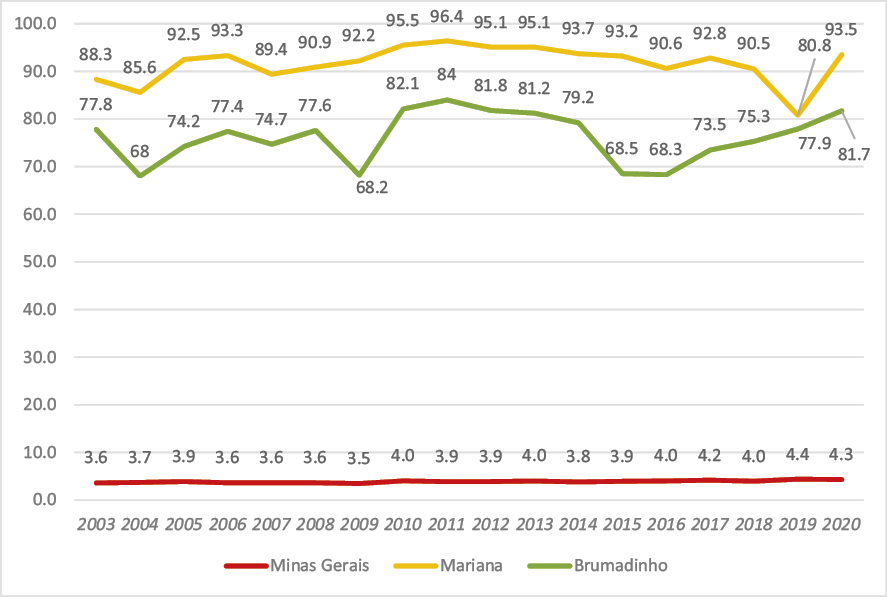
Figure 4. Percentual of the mining sector on the Tax Added Value for Mariana, Brumadinho, and Minas Gerais, between 2003 and 2022
Source: João Pinheiro Foundation (FJP), Board of Statistics and Information (Direi).
Note: The Value Added Tax (VAF) is an economic-accounting indicator used to calculate the municipal participation index in the transfer of revenue from the Tax on Operations related to the Circulation of Goods and on the Provision of Interstate and Intermunicipal Transport and Communication Services (ICMS) and the Tax on Industrialized Products (IPI). The percentage of the municipality’s Fiscal Added Value from the mineral extraction industry includes extraction, processing, and support activities.
The economy in the region has been affected in several ways, from agricultural activities that have been impacted due to the damage caused by the mud wave (with the impossibility of using water for irrigation and for livestock) to small local shops. The interruption of mining production in the municipality of Mariana also affected the economy (Victoria et al. 2019).
Economic alternatives such as agriculture and fisheries have been decisively impaired, limiting the desired local productive diversification (Coelho 2018). Dias Júnior and Verona (2020) explored the impacts of the collapse in Mariana through demographic aspects. With data from the National System of Live Births (SINASC) for the years 2013 to 2018, their results show that there was a fall in the number of live births in Mariana between 2015 and 2017.
The disaster had strong direct impacts on people. The damage caused was classified into three subcategories related to:
i. effects on public health and fundamental conditions of safety of persons.
ii. damage on the symbolic elements and access to education of the affected population.
iii. impacts on the forms of social organization of the population involved.
The damage to the population was varied, implying from the need to care for the wounded to important concerns about the psychological health of those affected, in addition to, obviously, dead and missing. This is added to problems relating to the safety of the affected population, linked to their temporary conditions of shelter (Lacaz, Porto & Pinheiro 2017).
As for social impacts, the disaster generated a loss of heritage of the population – as houses and shops and public and historical assets. The residents of Mariana received support from the Civil Defense of Minas Gerais regarding the shelter, material goods such as mattresses, hygiene kit and cleaning and basic items, as well as water supply. Residents also received humanitarian donations from several NGOs and different States of Brazil (Victoria et al. 2019).
According to the Brazilian Environment Agency (IBAMA), the affected sites had an interruption of many public services – such as health, epidemiological, sanitary, environmental and worker health surveillance. These sites can become vector points of diseases such as dengue, chikungunya, zika virus, schistosomes, chagas, leishmaniasis and problems with venomous animals. Due to water contamination, despite alerting the population and the creation of new water collection sites in some places, the affected population runs the risk of heavy metal contamination, generating serious health risks (Victoria et al. 2019).
The affected population had their entire lives drastically changed, having lost personal possessions, the source of sustenance and many have lost friends and relatives, as well as the landscape of the place where they lived. This whole situation has caused psychological shock in many people (Victoria et al. 2019). These people experienced, abruptly, the departure of the severely affected territories, and experienced several situations of violations of rights, such as loss of residence, loss of material and personal property, loss of civil documentation, in addition to loss of productivity and income, and family, social ties, and cultural communities (Gomes 2021). According to Lacaz, Porto & Pinheiro (2017), they also worry about how the definitive relocation will be, doubting whether they will return to their usual daily life. In addition, there is a strong sense of insecurity due to the fear of the disruption of other dams.
Some vulnerable populations – such as ribeirinhos (traditional people that live on the riverbanks and margins, and who have artisanal fishing as their main survival activity), native Brazilian Indians (such as the Krenak tribe, that dwells on the banks of the Doce River and depended closely on the river to survive) and other farmers (Aleixo & Andrade 2016; César & Carneiro 2017) – have been significantly affected.
This description of the impact of the disaster on the local population sets the context for the analysis of crime statistics, in the approach proposed by Clarke and Eck (2003). For this study the monthly incidence of violent crime, such as the number of victims of homicide and occurrences of theft and injury, were transformed into monthly rates – dividing the sum by the population, creating comparable data per 100,000 inhabitants (Clarke & Eck 2003).
The graph below (Figure 5) presents the rate of occurrences of violent crimes for each 100,000 inhabitants for Minas Gerais and for Mariana – both before and after the collapse. It shows a drop in both Mariana and Minas Gerais in a period that starts just after the collapse:
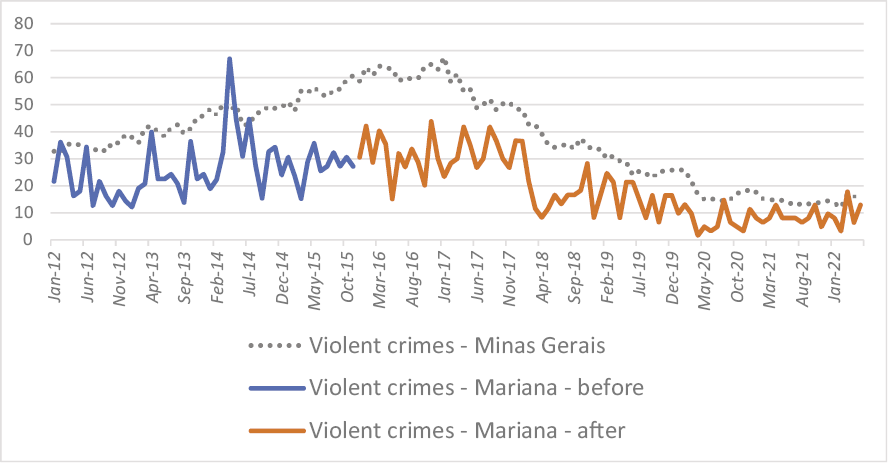
Figure 5. Rate of violent crimes per month, for Minas Gerais and Mariana – 2012-2022
Source: Occurrences: Armazém Sisp (official data warehouse for Minas Gerais state public security system). Demographic data: IBGE.
The graph below (Figure 6) presents the rate of occurrences of homicides for each 100,000 inhabitants for Minas Gerais and for Mariana – both before and after the collapse. It appears that Mariana observed a rise in homicides right after the collapse, followed by a drop in 2019:
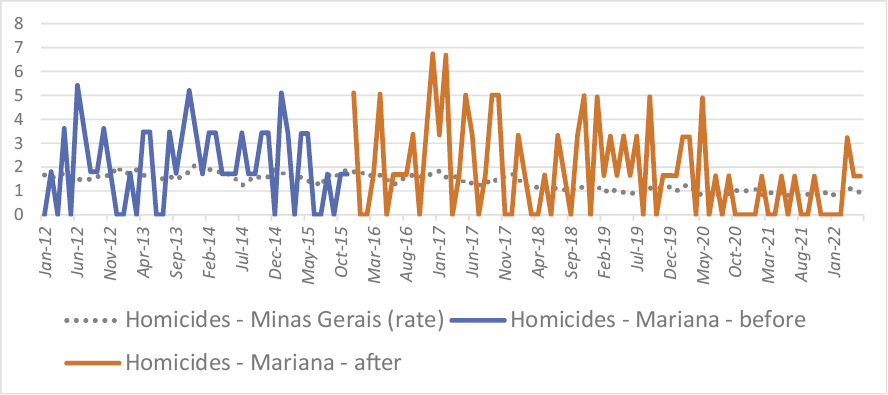
Figure 6. Rate of homicides per month, for Minas Gerais and Mariana – 2012-2022
Source: Occurrences: Armazém Sisp (official data warehouse for Minas Gerais state public security system). Demographic data: IBGE.
The graph below (Figure 7) presents the rate of occurrences of theft for each 100,000 inhabitants for Minas Gerais and for Mariana – both before and after the collapse. It shows a drop in both Mariana and Minas Gerais in a period that starts just after the collapse.
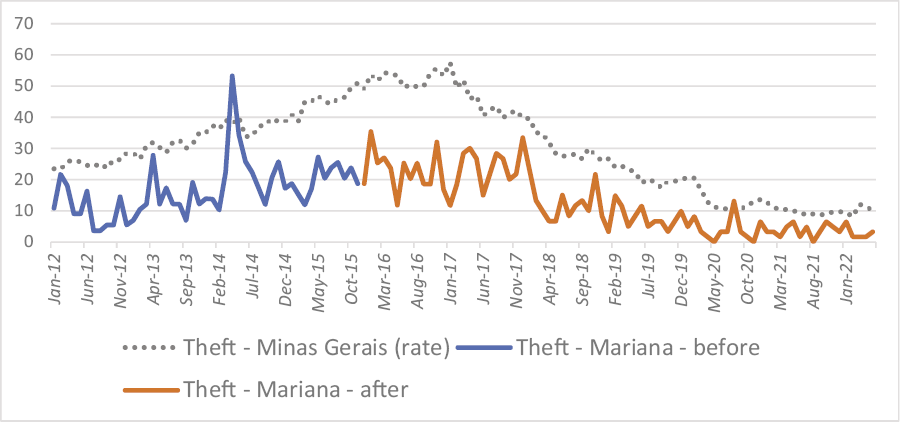
Figure 7. Rate of thefts per month, for Minas Gerais and Mariana – 2012-2022
Source: Occurrences: Armazém Sisp (official data warehouse for Minas Gerais state public security system). Demographic data: IBGE.
The graph below (Figure 8) presents the rate of occurrences of injury for each 100,000 inhabitants for Minas Gerais and for Mariana – both before and after the collapse. It shows a drop in both Mariana and Minas Gerais in a period that starts just after the collapse, followed by a rise in occurrences in Mariana in 2020 and 2021:
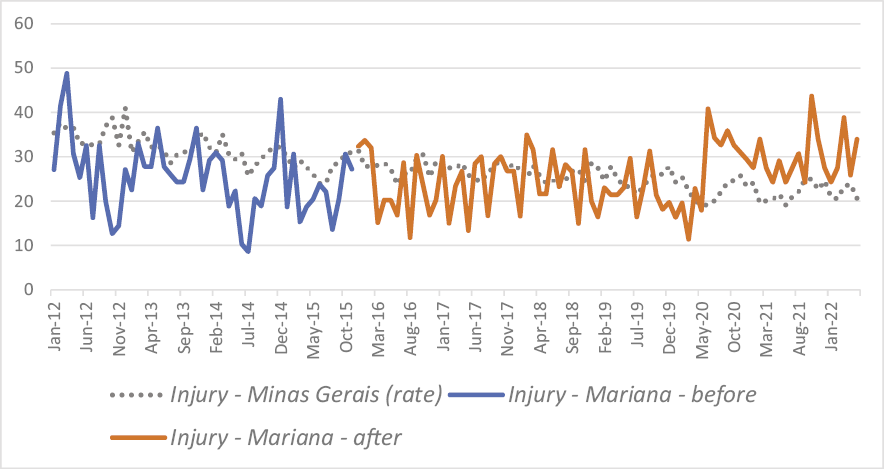
Figure 8. Rate of injuries per month, for Minas Gerais and Mariana – 2012-2022
Source: Occurrences: Armazém Sisp (official data warehouse for Minas Gerais state public security system). Demographic data: IBGE.
To proceed with the tests described by Triola (2001), it is necessary to calculate the descriptive statistics for each of the datasets separately, including the number of occurrences (n), mean, and standard deviation, and these are presented in Table 3 below:
| Data | n | Mean | Stand. Dev. |
|---|---|---|---|
| Violent crimes – before | 47 | 26.2048 | 10.2844 |
| Violent crimes – after | 78 | 18.3937 | 11.5852 |
| Homicides - before | 47 | 2.0722 | 1.6095 |
| Homicides – after | 78 | 1.7862 | 1.8754 |
| Theft – before | 47 | 16.6696 | 8.9549 |
| Theft – after | 78 | 11.8994 | 9.5509 |
| Injury – before | 47 | 25.3971 | 8.2656 |
| Injury - after | 78 | 25.5730 | 6.9444 |
Source: Occurrences: Armazém Sisp (official data warehouse for Minas Gerais state public security system). Demographic data: IBGE.
The next step in the methodology is to create boxplot charts of the dataset, on the same scale, to allow graphical comparations of statistics. The use of boxplot charts is an interesting analysis tool due to the visualization of different parameters in a same chart – such as mean, median, quartiles, and outliers.
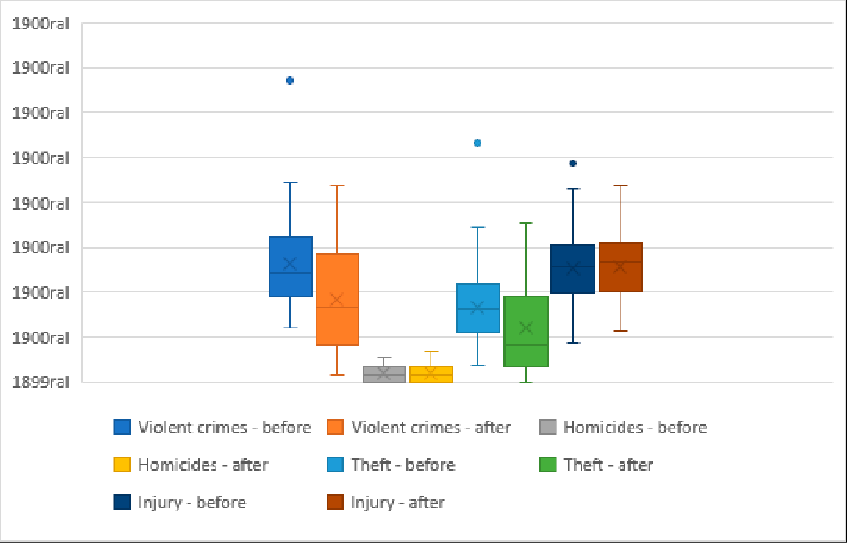
Figure 9. Boxplot for all the dataset
Source: Occurrences: Armazém Sisp (official data warehouse for Minas Gerais state public security system). Demographic data: IBGE.
It is possible to see big differences in the distribution for violent crimes, in general, and for theft. For the other problems, there is no big differences – except the fact that there are no outliers after the collapse. To assess it in a better way, it is necessary to generate histograms of the sets of data, to compare the distributions.
After analysing the descriptive statistics, it is possible to do the statistical tests if the means are equal or not for the significance level of 99% (α = 0.01). The table below presents the results for each variable:
| Variable | Z-statistic | Interpretation |
|---|---|---|
| Violent crimes | 3.9197 | Outside of acceptance region (-2.575, 2.575), which means that the means are statistically different |
| Homicides | 0.9034 | Inside of acceptance region (-2.575, 2.575), which means that the means are statistically equal |
| Theft | 2.8130 | Outside of acceptance region (-2.575, 2.575), which means that the means are statistically different |
| Injury | -0.1222 | Inside of acceptance region (-2.575, 2.575), which means that the means are statistically equal |
Source: Occurrences: Armazém Sisp (official data warehouse for Minas Gerais state public security system). Demographic data: IBGE.
The results of the statistical test of averages allow us to affirm that statistical differences exist between the means before and after the dam collapse for violent crimes, in general, and thefts, specifically.
The social changes imposed by the collapse seem to cause the averages of the parameters treated to be statistically different from the means before the collapse in Mariana. In other words, these differences do confirm there are real impacts of the accidents on crime trends, and that these changes on data they are not simply part of the seasonal variation of the phenomenon.
Results for Brumadinho
On January 25th of 2019, Mina do Feijão mining dam, managed by Vale, collapsed in Brumadinho, 50 kilometres from Belo Horizonte. This massive accident killed almost three hundred people – most of them workers at the mine, representing not only a humanitarian disaster, but one of Brazil’s worst environmental disasters. The collapse destroyed forests and polluted rivers across the region.
Despite the difficulty in mapping the impact, due to the forest density that ‘hides’ the directly affected area (Freitas 2021), the collapse appears to have severely compromised the geomorphological dynamics of Paraopeba river, with the complete burial of the bottom of the valley (Carvalho, Magalhães Júnior & Barros 2021) – as seen in the imagery shown in Figure 10. The Paraopeba river provided drinking water to 3 million people, but the high-density of minerals following the tailings spill, meant the river water was impossible to drink. The resulting social impacts were widespread (Cyrne et al. 2020).
Because it is a recently occurred tragedy, at the time of writing in 2023, its impacts have not yet been fully measured, but it is possible to observe the change that was promoted in the landscape of the place. Figure 10 provides a visual indication of the reach of the impact:
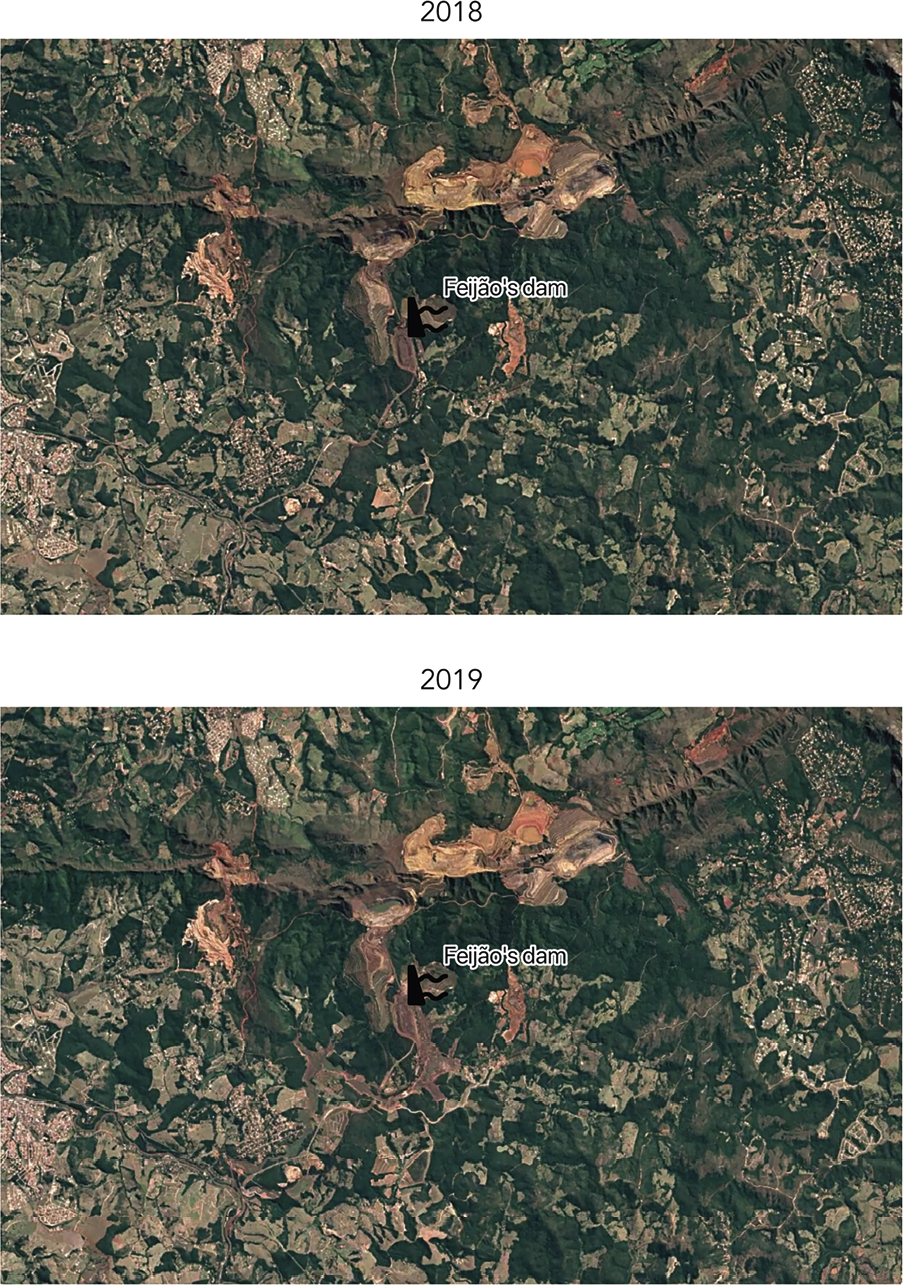
Figure 10. Timelapse of satellite imagery from Brumadinho before and after the dam collapse – 2018-2019
Source: The author, with data from Google Earth Engine Timelapse (2022).
The collapse is still the subject of many studies – as an example, there is an entire journal issue about the case3. As in Mariana case, the economy in Brumadinho’s region has been affected in several ways – from the loss of buildings to the pause on production.
In the affected area there were small properties of family farmers, rural communities and indigenous peoples who lived on the banks of the river. Among the main productive activities were the production of vegetables and fruits to supply urban centers located in the region; inns for tourist service; and other leisure facilities. The impacts caused, thus, the loss of several fundamental rights, such as: land use, housing, water, light, mobility, among others (Silva et al. 2019).
As in Mariana case, the disaster had strong direct impacts on people, specifically on public health and safety, damage on the symbolic elements and access to education and on the forms of social organization. As an example, Antunes-Rocha, Hunzicker and Fantinel (2020) show the impacts of the collapse for the provision of public services in Brumadinho – specially on public education. Beyond the hundreds of dead people – some of them still missing in the mud –, there are problems relating to the safety of the affected population, specially concerning its sheltering.
The UN’s Sustainable Development Goals (SDG) provide a useful analytical tool to show the impact of the disaster on life and livelihoods in Brumadinho (Carvalho et al. 2019). Thus, the authors analysed the impacts on SDG 1, 2, 3, 8, 11 and 16, drawing also on the work of Carvalho et al. (2019).
• SDG 1 – No poverty: despite the efforts to provide emergency aid to the citizens of Brumadinho, Carvalho et al. (2019) affirm that poverty has been aggravated in the municipality, given that the disaster destroyed the source of income of hundreds of people.
• SDG 2 – Zero hunger: agriculture is one of the most important productive activities of any nation, as it guarantees food production, supplies raw materials for fuel manufacturing and generates jobs. In Brumadinho, although the main economic activity is mining, agriculture plays an important role in the revenues of hundreds of local entrepreneurs. According to data from IBGE, of the 20,500 hectares of cropping land, 17,000 were from individual producers, but the mud from the dam affected much of the rural area of the municipality.
• SDG 3 – Good health and well-being: the results obtained pointed to the possibility of outbreaks of infections, the worsening of chronic diseases among those affected, the worsening of their mental health and problems such as domestic accidents and respiratory diseases resulting from mud toxicity. The disaster also caused an overload on the health system, contraction of health professionals, in addition to what already exists in the municipality with a cost of more than $300,000 per month. Another effect was the increase in the consumption of 80% of drugs to treat anxiety and 60% of antidepressants, that is, a mental impact on the local population.
• SDG 8 – Decent work and economic growth: economically dependent on mining, Brumadinho lost about 50% of its production after the collapse. For tourism, the reflections of the disaster began at about the same moment the dam broke. The Inhotim Institute, one of the largest open-air museums in the world, for example, remained closed for nearly ten days in respect for the victims. The tourism sector had been recovering from the impacts generated by a yellow fever outbreak in 2018 (a 50% drop in visitor numbers). Before the tragedy, the average occupancy rate of hotels and inns in Brumadinho was 85% and, after the tragedy, it is estimated that the negative impact on tourism has reached 90%. The municipality of Brumadinho has its main economic base sustained by mining activity, corresponding to 60% of the municipality’s revenue. Vale alone generated about 2,000 jobs, which were affect by the collapse.
• SDG 11 – Sustainable cities and communities: Among the impacts of the disaster it is possible to mention the isolation of rural communities, which have lost access to the city and services because roads and trails have been destroyed or interrupted by mud.
• SDG 16 – Peace, justice and strong institutions: the Brazilian Justice accepted, on 14/02/2019, the complaint made by the Public Ministry of Minas Gerais (MPMG) about the rupture of the dam. In addition, the accused will answer for qualified homicide and are also accused of crimes against fauna and flora, and crimes of pollution.
As happened previously in Mariana, the affected population in Brumadinho had their entire lives drastically changed, having lost personal possessions, the source of sustenance and friends and relatives, as well as the landscape of the place where they lived. This is also the case for the vulnerable populations – such as ribeirinhos, native Brazilian Indians and other farmers.
Again, for this study, data before and after the dam collapse were collected, for violent crime, number of victims of homicide, occurrences of completed theft and injury, and the incidence per 100,000 inhabitants was calculated (Clarke & Eck 2003). Figure 11 presents the rate of occurrences of violent crimes for Minas Gerais and for Brumadinho – both before and after the collapse. It shows a drop in Brumadinho after the collapse, following a general trend to drop across the province of Minas Gerais.
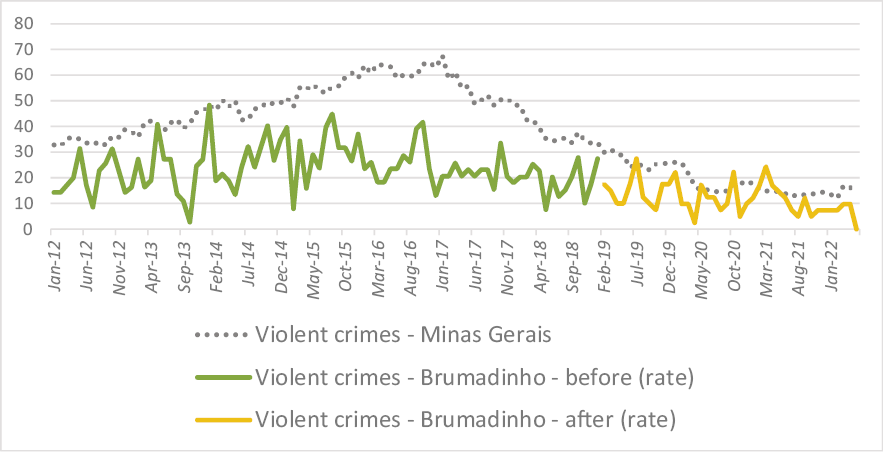
Figure 11. Rate of violent crimes per month, for Minas Gerais and Brumadinho – 2012-2022
Source: Occurrences: Armazém Sisp (official data warehouse for Minas Gerais state public security system). Demographic data: IBGE.
The graph below (Figure 12) presents the rate of occurrences of homicides for Minas Gerais and for Brumadinho – both before and after the collapse. It shows that Brumadinho observed a drop in homicides right after the collapse, followed by a rise in last months of 2020.
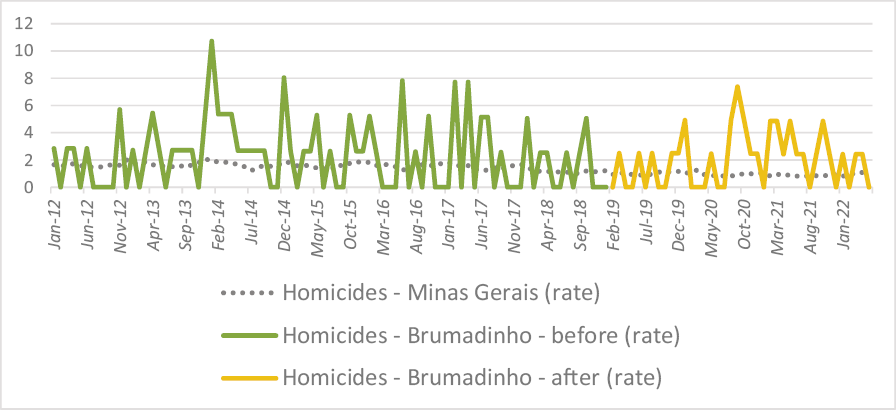
Figure 12. Rate of homicides per month, for Minas Gerais and Brumadinho – 2012-2022
Source: Occurrences: Armazém Sisp (official data warehouse for Minas Gerais state public security system). Demographic data: IBGE.
The graph below (Figure 13) presents the rate of occurrences of theft for Minas Gerais and for Brumadinho – both before and after the collapse. It shows a drop in both Brumadinho after the collapse, following a general trend to drop across the province.
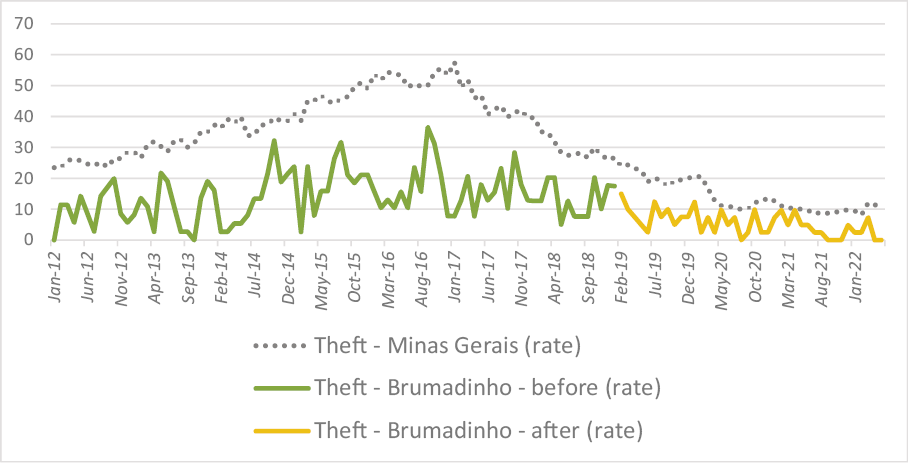
Figure 13. Rate of thefts per month, for Minas Gerais and Brumadinho – 2012-2022
Source: Occurrences: Armazém Sisp (official data warehouse for Minas Gerais state public security system). Demographic data: IBGE.
The graph below (Figure 14) presents the rate of occurrences of injury for Minas Gerais and for Brumadinho – both before and after the collapse. It shows a drop in Brumadinho in a period that starts just after the collapse, followed by a rise in occurrences in the final part of 2019:
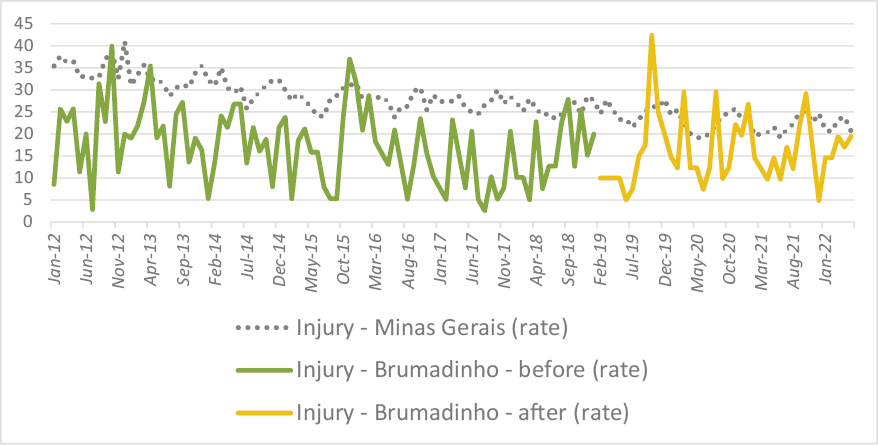
Figure 14. Rate of injuries per month, for Minas Gerais and Brumadinho – 2012-2022
Source: Occurrences: Armazém Sisp (official data warehouse for Minas Gerais state public security system). Demographic data: IBGE.
As before, to proceed the test showed by Triola (2001), it is necessary to calculate the descriptive statistics for each of the datasets, including the number of occurrences (n), mean, and standard deviation, presented in the table below:
| Data | n | Mean | Stand. Dev. |
|---|---|---|---|
| Violent crimes – before | 85 | 23.6104 | 8.9365 |
| Violent crimes – after | 40 | 11.9243 | 5.9644 |
| Homicides - before | 85 | 2.2787 | 2.4849 |
| Homicides – after | 40 | 2.0201 | 1.9892 |
| Theft – before | 85 | 14.1909 | 7.7794 |
| Theft – after | 40 | 5.4200 | 3.9328 |
| Injury – before | 85 | 17.1493 | 8.3860 |
| Injury - after | 40 | 16.0135 | 7.7149 |
Source: Occurrences: Armazém Sisp (official data warehouse for Minas Gerais state public security system). Demographic data: IBGE.
The next step in the methodology is to create boxplot charts of the dataset, on the same scale, to allow graphical comparations of statistics. Again, the use of boxplot charts is an interesting analysis tool due to the visualization of different parameters in a same chart – such as mean, median, quartiles, and outliers.
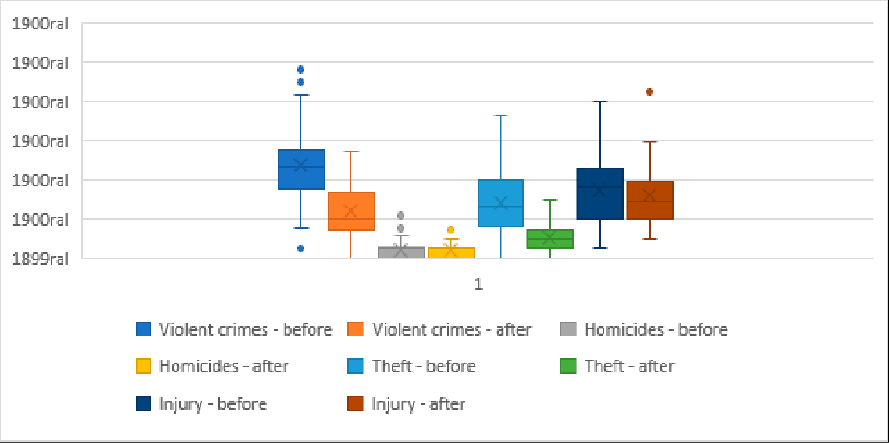
Figure 15: Boxplot for all the Brumadinho dataset
Source: Occurrences: Armazém Sisp (official data warehouse for Minas Gerais state public security system). Demographic data: IBGE.
It is possible to see big differences in the distribution for violent crimes, in general, and for theft and injury, with a significant fall. For homicides, there is no big changes. To assess it in a better way, it is necessary to generate histograms of the sets of data, to compare the distributions.
After analysing the descriptive statistics, it is possible to do the statistical tests if the means are equal or not for the significance level of 99% (α = 0.01). The table below presents the results for each variable:
| Variable | Z-statistic | Interpretation |
|---|---|---|
| Violent crimes | 8,6412 | Outside of acceptance region (-2.575, 2.575), which means that the means are statistically different |
| Homicides | 0,6244 | Inside of acceptance region (-2.575, 2.575), which means that the means are statistically equal |
| Theft | 8,3679 | Outside of acceptance region (-2.575, 2.575), which means that the means are statistically different |
| Injury | 0,7464 | Inside of acceptance region (-2.575, 2.575), which means that the means are statistically equal |
Source: Occurrences: Armazém Sisp (official data warehouse for Minas Gerais state public security system). Demographic data: IBGE.
The results of the statistical test of averages allow us to affirm statistical differences between the means before and after the dam collapse for violent crimes, in general, and thefts, specifically. In other words, the social changes imposed by the collapse seem to cause the averages of the parameters treated to be statistically different from the means before the collapse in Brumadinho.
Conclusions
As its name denotes, the state of Minas Gerais (‘General mines’) is a territory rich in minerals and dependent on mining. Due to its mining reserves, the state also has the biggest concentration of tailings dams built to retain mining waste, according to data from Brazilian National Agency on Water. As noted, the region experienced major tailings dam accidents in the last decade, in Mariana in 2015 and in Brumadinho, 2019.
These disasters cannot have their impacts reduced to the municipalities of occurrence and those affected to the immediate number of deaths and injured or even the loss of homes. Its impacts go further and include the contamination and environmental changes they produce in the areas and rivers affected, as well as the abrupt change in social organization and ways of living and working historically constituted in the territories, with effects on health. In addition to the numbers of ‘affected’ traditionally defined by civil defenses (displaced, homeless, dead, injured, and sick) and recorded during the rescue and relief period, one should consider all those who had their living and working conditions affected in the different territories (Freitas et al. 2019).
To assess the impacts of these accidents on time scales of crime and violence in Mariana and Brumadinho, as a new face of extractivism, we accessed public crime data organized by Minas Gerais’ Justice and Public Security Secretariate and undertook time series analysis of the changes in crime and other violence-related problems in both before and after scenarios, for both locations.
The results of the statistical tests corroborate the hypothesis presented by authors such as Sapori & Soares (2014), that it is more important to understand the spatial and social circumstances in which crime is practiced, beyond the approaches that concern the reasons why criminals are engendered (Clarke & Eck 2003).
The disaster had strong direct impacts on people, such as effects on public health and fundamental conditions of safety and health of persons, damage to the symbolic and cultural elements and access to education of the affected population and impacts on the forms of social organization of the population involved, many of whom were taken to shelters instead of being able to stay their own houses and becoming dependent on donations from various NGOs and from the government (Antunes-Rocha, Hunzicker & Fantinel 2020; Carvalho et al. 2019; Gomes 2021; Lacaz, Porto & Pinheiro 2017; Silva et al. 2019; Victoria et al. 2019). These impacts disproportionately affected people who were already in a vulnerable status (Aleixo & Andrade2016; César & Carneiro 2017).
As stated by these authors, the social changes imposed by the two collapses would seem to have changed the conditions in which criminals and their victims coexist in a specific location, even though neither can be identified in advance – raising questions of what causes crime trends to change.
These changes cause the averages of the parameters treated to be statistically different from the means before the collapse in both Mariana and Brumadinho. These observed differences on means do confirm there are real impacts on the incidents of crime trends, and that these changes in data are not simply part of the seasonal variation of the phenomenon.
In other words, the social changes imposed by the collapse of the tailings dams do seem to cause the averages of the parameters treated to be statistically different from the means before the collapse in both cities. The theory of Sapori and Soares (2014) provides a useful reminder that there are factors that can affect activities and victimization, including exposure to public places, proximity between victim and potential offender, protection capacity, attractiveness of victims or targets and nature of the crime.
It is possible to affirm that there has been a decrease in the exposure to public places, in the time allocated to contacts and social interactions, in the contacts between victims/targets and probable offenders, as well as on attractiveness of the victims or targets – which may explain the drop of theft occurrences.
According to Agnew (1992), we expected a rise of violence in society associated with the re-management of entire communities, due to the stressful situation which the affected population would experience. Many of the affected people lost their houses, and had to start living in a shelter, experiencing conflicts with other families. The data analysed showed that there was a slight drop in homicides in both cities. Brumadinho had a mean of 2.27 homicides per month before the collapse. After the incident, it dropped to 2.02 homicides. In the recent year, the city has experienced a rise in this kind of crime, which may lead to different results in the future. In Mariana, despite the spike observed in 2017, there was a mean of 2.07 homicides before the accident, which dropped to 1.78 homicides per month after the collapse.
The data on injuries had different effects in each of the cities. Brumadinho experienced a fall in the monthly mean – from 17.14 cases to 16.01. For its turn, Mariana experienced a slight rise in the monthly mean – from 25.39 cases per month before the collapse to 25.57 after it. This rise occurred mainly during the COVID-19 pandemic, starting in 2020. This can be explained by the different impact of the collapse in Mariana – while the collapse in Brumadinho was abrupt and fast, killing more than 300 people, the collapse in Mariana killed fewer people, but destroyed a bigger part of the human settlement, which lead to a larger number of people living in shelter and temporary settlement. Thus, in Mariana, this was likely to have a bigger impact on crime.
The data on theft (which leads the total of violent crime, because theft represents about 85% of the total) show a drop in both data sets. Mariana experienced a significant fall from a monthly mean of 14.19 occurrences before the collapse to 5.42 after it. Brumadinho experienced a smaller drop, from 16.66 occurrences to 11.89. Again, this can be explained by the bigger impact of Mariana’s collapse on human settlements, compared to Brumadinho.
It is possible to affirm that, especially in Mariana, due to the impact of the collapse on human settlement, there was a change in the situational aspects for crime presented by Clarke and Eck (2003). In other words, it is possible to affirm that the re-settlement of people in shelters or temporary houses increased the effort to commit crime and the risk of being caught and the collapse itself diminished the amount of available goods to be taken. The bigger part played by the State and the mining companies in everyday lives may have impacted this, extending the guardianship and the formal surveillance over the goods, that led to a greater enforcement of law and rules.
Using the work of Clarke and Eck (2003), this study has shown how a rates of violent crime are affected by mining disasters. These results can be used to design better responses in terms of welfare programs or compensations effort in disasters. One way is to strengthen the situational prevention measures (shown in Table 2). The State – represented by its agents, such as government officials, the police, municipal guards, and so on – has an important role (as described by the Brazilian constitution and other laws) as guardians and law enforcers. If it is well done, it is easier to assure the well-being of the mining communities. It is also necessary to prioritise certain objectives, such as (i) remedying the damage; (ii) restoring the biophysical environment to a desired prior state; (iii) restoring or improving the livelihoods of those affected; and (iv) compensating for damage that cannot be remedied (Sánchez et al. 2018).
References
Agnew, R. 1992, ‘Foundation for a general strain theory of crime and delinquency’. Criminology, vol. 30, no. 1, pp. 47–88. https://doi.org/10.1111/j.1745-9125.1992.tb01093.x
Aleixo, L. S. P. & Andrade, P. G. G. 2016, ‘O rompimento da barragem em Mariana: impactos na comunidade indígena Krenak à luz da jurisprudência interamericana’, Revista da Faculdade de Direito do Sul de Minas, vol. 32, no. 2, pp. 283-296. https://revista.fdsm.edu.br/index.php/revistafdsm/article/view/188/189
Antunes-Rocha, M. I., Hunzicker, A. C. M. & Fantinel, L. M. 2020, ‘O rompimento da barragem B1 da Mina Córrego do Feijão e os desafios para a educação’, Ciência e Cultura, vol. 72, no. 2, pp. 17-21. https://doi.org/10.21800/2317-66602020000200007
Beato Filho, C. C. 1998, ‘Determinantes da criminalidade em Minas Gerais’, Revista Brasileira de Ciências Sociais, vol. 13, no. 37, pp. 74-87. https://doi.org/10.1590/S0102-69091998000200004
Brantingham, P. & Brantingham, P. (eds.) c. 1981, Environmental Criminology, Sage, Beverly Hills, CA.
Caldeira, T. P. R. 2000, Cidade de muros: crime, segregação e cidadania em São Paulo,: Ed. 34/Edusp, São Paulo.
Carvalho, M. M., Braz, S. F., Silva, L. H. V., Rodrigues, P. P., Galvão, P. H. G., Souza, C. F. C. & Longo, R. M. 2019, ‘Brumadinho-MG após o rompimento da barragem: uma discussão à luz dos Objetivos de Desenvolvimento Sustentável’, Revista Humanidades & Inovação, vol. 13, no. 9, pp. 365-375. https://revista.unitins.br/index.php/humanidadeseinovacao/article/view/6890
Carvalho, R. P. B., Magalhães Júnior, A. P. & Barros, L. F. P. 2021, ‘Implicações hidrogeomorfológicas do rompimento da barragem de rejeito da Mina do Córrego do Feijão – MG’, Caderno de Geografia. vol. 31, no. 65, pp. 518-545. https://doi.org/10.5752/P.2318-2962.2021v31n65p518
Carvalho Filho, A. 2008, Solos e Ambientes do Quadrilátero Ferrífero (MG) e Aptidão Silvicultural dosTabuleiros Costeiros, UFLA, Lavra.
César, P. S. M. & Carneiro, R. 2017, ‘O rompimento da barragem em Mariana para as populações historicamente vulneráveis’, Revista Livre de Sustentabilidade e Empreendedorismo, vol. 2, no. 1, pp. 223-240. http://www.relise.eco.br/index.php/relise/article/view/65/49
Clarke, R. V. & Eck, J. E. 2003, Become a Problem-Solving Crime Analyst, Jill Dando Institute of Crime Science, University College London.
Coelho, T. P. 2018, ‘Minério-dependência em Brumadinho e Mariana’ Lutas Sociais, vol. 22, no. 41, pp. 252-267. https://doi.org/10.23925/ls.v22i41.46681
Cohen, L. E. & Felson, M. 1979, ‘Social change and crime rate trends: A routine activity approach’, American Sociological Review, vol. 44, no. 4, pp. 588–608. https://doi.org/10.2307/2094589
Cyrne, R. C. O., Sales, R. A., Araujo, M. J. F. & Araujo, M. V. F. 2020, ‘Remoção de metais pesados da água do rio Paraopeba após o rompimento da barragem mina Córrego do Feijão’, Brazilian Journal of Development. vol. 16, no. 3, pp. 10371-10379. https://doi.org/10.34117/bjdv6n3-060
Del Priore, M. & Venancio, R. 2010, Uma Breve História do Brasil, Planeta, São Paulo.
Dias Júnior, C. S. & Verona, A. P. 2020, ‘Rompimento da barragem de Fundão e o número de nascidos vivos no município de Mariana, Minas Gerais, Brasil, 2013-2018’, IX Congreso de la Asociación Latinoamericana de Población, ALAP 2020 https://congresosalap.com/alap2020/resumos/0001/PPT-eposter-trab-aceito-0051-2.PDF
Figueira, M. 2016, ‘Espaços urbanos seguros: teorias, abordagens e metodologias’, In: Convivência e segurança cidadã: reflexões por uma nova abordagem de segurança pública. UNDP, Brasilia, pp. 129-134.
Fontes, R. N. & Lopes, I. S. 2017, ‘As representações da mídia sobre o rompimento da barragem do Fundão em Mariana, Minas Gerais’ Revista Espacios, vol. 38, no. 34. http://www.revistaespacios.com/a17v38n34/a17v38n34p32.pdf
Freitas, C. M., Barcellos, C., Asmus, C. I. R. F., Silva, M. A. & Xavier, D. R. 2019, ‘Da Samarco em Mariana à Vale em Brumadinho: desastres em barragens de mineração e Saúde Coletiva’, Caderno de Saúde Pública, vol. 35, no. 5. https://doi.org/10.1590/0102-311x00052519
Freitas, R. M. 2021, Proposta de melhoria do processo de definição da área diretamente afetada pelo rejeito nas regiões encobertas pela vegetação: estudo de caso: Barragem B1 da Mina Córrego do Feijão – Brumadinho – MG. PhD thesis, Universidade Federal de Minas Gerais. https://repositorio.ufmg.br/handle/1843/36709
Gartner, A. 2008 ‘Desenho do espaço público como ferramenta para a prevenção da violência’, Revista Brasileira de Segurança Pública, vol. 2, no. 1, pp. 56-68. https://revista.forumseguranca.org.br/index.php/rbsp/article/view/46
Gomes, S. O. 2021, Os impactos sociais vivenciados pela pessoa idosa após o rompimento da barrage de Fundão no município de Mariana – MG. Masters Thesis, Universidade Federal de Viçosa, 2021. https://www.locus.ufv.br/bitstream/123456789/28809/1/texto%20completo.pdf
Guillén, C. S. J. 2013, ‘Criminología ambiental: un área en expansión’, Ars Iuris Salamanticensis, vol. 1, no. 1, pp. 33-38 https://gredos.usal.es/bitstream/handle/10366/128906/Criminologia_ambiental_un_area_en_expans.pdf,jsessionid=1E79B98F4B270F0CF54A8B58A75CDFC4?sequence=1
Lacaz, F. A. C., Porto, M. F. S. & Pinheiro, T. M. M. 2017, ‘Tragédias brasileiras contemporâneas: o caso do rompimento da barragem de rejeitos de Fundão/Samarco’, Revista Brasileira de Saúde Ocupacional, v. 42. https://doi.org/10.1590/2317-6369000016016
Omachi, C. Y., Siani, S M. O., Chagas, F. M., Mascagni, M. L., Cordeiro, M., Garcia, G. D., Thompson, C. C., Siegle, E. & Thompson, F. L. 2018, ‘Atlantic Forest loss caused by the world´s largest tailing dam collapse (Fundão Dam, Mariana, Brazil)’, Remote Sensing Applications: Society and Environment, vol. 12, pp. 30-34. https://doi.org/10.1016/j.rsase.2018.08.003
Mura, J. C., Gama, F. F., Paradella, W. R., Negrão, P., Carneiro, S., Oliveira, C.G. & Brandão, W.S. 2018, ‘Monitoring the vulnerability of the dam and dikes in Germano iron mining area after the collapse of the tailings dam of Fundão (Mariana-MG, Brazil) using DInSAR techniques with TerraSAR-X Data’, Remote Sensing, vol.10, 1507. https://doi.org/10.3390/rs10101507
Newman, O. 1972, Defensible Space: Crime Prevention through Urban Design, Macmillan, New York.
Pinto-Coelho, R. M. 2015, ‘Existe governança das águas no Brasil? Estudo de caso: O rompimento da Barragem de Fundão, Mariana (MG)’, Arquivos do Museu de História Natural e Jardim Botânico, vol. 24, nos.1-2, pp. 16-43. https://periodicos.ufmg.br/index.php/mhnjb/article/view/6260
Saadi, A. & Campos, J. C. F. 2015, ‘Geomorfologia do caminho da lama: contexto e consequências da ruptura da Barragem do Fundão (novembro 2015, Mariana–MG)’, Arquivos do Museu de História Natural e Jardim Botânico, vol. 24, nos.1-2, pp. 63-103. https://periodicos.ufmg.br/index.php/mhnjb/article/view/6262
Sánchez, L. E., Alger, K., Alonso, L., Barbosa, F. A. R., Brito, M. C. W., Laureano, F. V., May, P., Roeser, H. & Kakabadse, Y. 201, Os impactos do rompimento da Barragem de Fundão: O caminho para uma mitigação sustentável e resiliente. Relatório Temático no. 1 do Painel do Rio Doce. União Internacional para a Conservação da Natureza e Recursos Naturais (UICN), Gland, Switzerland. https://doi.org/10.2305/IUCN.CH.2018.18.pt
Sapori, L. F. & Soares, G. A. D. 2014, Por que cresce a violência no Brasil? Autêntica/Editora Puc Minas, Belo Horizonte.
Silva, D. L., Ferreira, M. C. & Scotti, M. R. ‘O maior desastre ambiental brasileiro: de Mariana (MG) a Regência (ES)’, Arquivos do Museu de História Natural e Jardim Botânico, v. 24, nos. 1-2, pp. 136-158. https://periodicos.ufmg.br/index.php/mhnjb/article/view/6264
Siqueira, P. P. 2016, ‘Espaços Urbanos Seguros – Relações entre arquitetura e criminologia no contexto urbano e a importância do planejamento participativo’, In: Convivência e segurança cidadã: reflexões por uma nova abordagem de segurança pública. UNDP, Brasilia, pp. 123-128.
Stevenson, W. J. 1981, Estatística Aplicada à Aadministração, Harper e Row do Brasil, São Paulo.
Triola, M. F. 2001, Elementary Statistics, 8th ed., Longman, Boston.
Vitoria, F. C., Bandini, B., Silva, E. R. & Almeida, J. R. 2019 ‘Desastre ambiental da barragem de Fundão, MG – Análise de impactos socioambientais’, Revista Internacional de Ciências, vol. 9, no. 3, pp. 2-15 https://doi.org/10.12957/ric.2019.40296
1 Data available online on: http://www.seguranca.mg.gov.br/2018-08-22-13-39-06/dados-abertos
2 Considered as the sum of all the occurrences of thirteen different problems, such as completed sexual assault, attempted sexual assault, completed sexual assault with underaged-vulnerable victim, attempted sexual assault with underaged-vulnerable victim, completed extortion, attempted extortion, completed extortion through kidnapping, attempted extortion through kidnapping, completed theft, attempted theft, completed kidnapping and private prison, attempted kidnapping and private prison, and completed homicide.
3 The Brazilian journal Ciência & Cultura published a special issue one year after the disaster in Brumadinho. The publication compiles articles by Brazilian researchers that deal with the socio-environmental impacts of the disaster, as well as reports on topics related to the cultural and scientific universe. The issue is available online on https://revistacienciaecultura.org.br/
